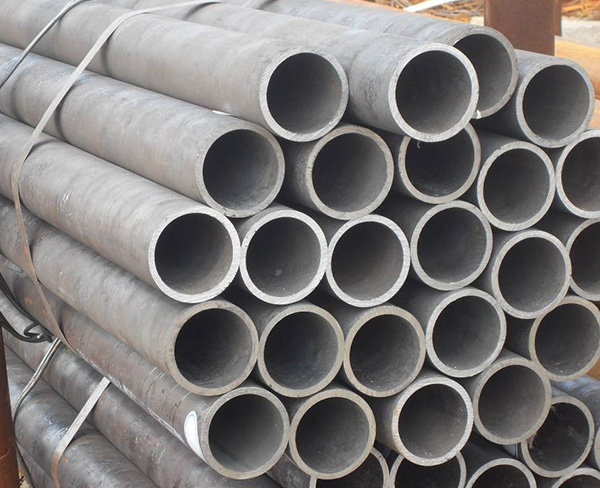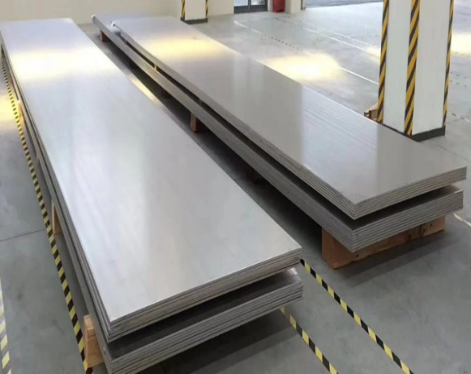The effect of different elements on stainless steel seamless pipes
1. Carbon (C): The carbon content in the steel increases, the yield point and tensile strength increase, but the plasticity and impact decrease. When the carbon content exceeds 0.23%, the welding performance of the steel deteriorates, so the low-alloy structural steel used for welding generally does not contain more than 0.20% carbon. High carbon content will also reduce the atmospheric corrosion resistance of steel, and high carbon steel in the open stock yard is easy to rust; in addition, carbon can increase the cold brittleness and aging sensitivity of steel.
2. Silicon (Si): Silicon is added as a reducing agent and deoxidizer in the steelmaking process, so killed steel contains 0.15-0.30% silicon. If the silicon content in the steel exceeds 0.50-0.60%, silicon is considered an alloying element. Silicon can significantly improve the elastic limit, yield point and tensile strength of steel, so it is widely used as spring steel. Adding 1.0-1.2% silicon to quenched and tempered structural steel can increase the strength by 15-20%. The combination of silicon and molybdenum, tungsten, chromium, etc. can improve corrosion resistance and oxidation resistance, and can manufacture heat-resistant steel. Low carbon steel with silicon content of 1-4% has extremely high magnetic permeability, and is used in electrical industry to make silicon steel sheets. An increase in the amount of silicon will reduce the weldability of the steel.
3. Manganese (Mn): In the process of steelmaking, manganese is a good deoxidizer and desulfurizer. Generally, manganese in steel is 0.30-0.50%. When more than 0.70% is added to carbon steel, it is considered "manganese steel". Compared with ordinary steel, it not only has sufficient toughness, but also has higher strength and hardness, which improves the hardenability of steel and improves the hot workability of steel. The increase of manganese content weakens the corrosion resistance of steel and reduces the welding performance.
4. Phosphorus (P): In general, phosphorus is a harmful element in steel, which increases the cold brittleness of steel, makes welding performance worse, reduces plasticity, and makes cold bending performance worse. Therefore, the phosphorus content in steel is usually required to be less than 0.045%, and the requirements for high-quality steel are lower.
5. Sulfur (S): Sulfur is also a harmful element under normal circumstances. It makes the steel hot brittle, reduces the ductility and toughness of the steel, and causes cracks during forging and rolling. Sulfur is also detrimental to weldability, reducing corrosion resistance. Therefore, the sulfur content is usually required to be less than 0.055%, and the high-quality steel is required to be less than 0.040%. Adding 0.08-0.20% sulfur to steel can improve machinability, usually called free-cutting steel.
6. Chromium (Cr): In stainless steel pipes, chromium can significantly improve strength, hardness and wear resistance, but at the same time reduce plasticity and toughness. Chromium can also improve the oxidation resistance and corrosion resistance of steel, so it is an important alloying element of stainless steel and heat-resistant steel.
7. Nickel (Ni): Nickel can improve the strength of steel while maintaining good plasticity and toughness. Nickel has high corrosion resistance to acid and alkali, rust and heat resistance at high temperature. However, since nickel is a relatively scarce resource, other alloying elements should be used instead of nickel-chromium steel as much as possible.
8. Molybdenum (Mo): Molybdenum can refine the grains of steel, improve hardenability and thermal strength,Maintain sufficient strength and creep resistance at high temperature (long-term stress at high temperature, deformation occurs, called creep). Molybdenum is added to structural steel to improve mechanical properties. The brittleness of alloy steel due to fire can also be suppressed.

Control of the hardness of stainless steel seamless pipes
1. The extrusion frame of the stainless steel pipe should not be too dense, and there should be a gap between the materials, especially the small and thick materials that are not ventilated need to have a larger interval.When the pipe material is combined with the small material and the sheet material in one frame, the pipe material is placed on the bottom, which is conducive to the aging circulation air supply.
2. Temperature setting and control: Usually, there is a certain error between the temperature and the displayed temperature. When setting the table temperature, it should be set according to the actual temperature of the furnace, and pay close attention to the fluctuation of the temperature.
3. Aging insulation of stainless steel pipes: aging should be carried out in strict accordance with the process requirements, and the insulation time should be appropriate to prevent insufficient hardness due to under-aging or over-aging.
4. Before the stainless steel tube is charged into the furnace, other special alloys and ordinary alloys should be separately charged into the furnace for aging. Due to the production reasons, when the aging is really required in the same furnace, the process of special alloy should be used for aging.
1. Carbon (C): The carbon content in the steel increases, the yield point and tensile strength increase, but the plasticity and impact decrease. When the carbon content exceeds 0.23%, the welding performance of the steel deteriorates, so the low-alloy structural steel used for welding generally does not contain more than 0.20% carbon. High carbon content will also reduce the atmospheric corrosion resistance of steel, and high carbon steel in the open stock yard is easy to rust; in addition, carbon can increase the cold brittleness and aging sensitivity of steel.
2. Silicon (Si): Silicon is added as a reducing agent and deoxidizer in the steelmaking process, so killed steel contains 0.15-0.30% silicon. If the silicon content in the steel exceeds 0.50-0.60%, silicon is considered an alloying element. Silicon can significantly improve the elastic limit, yield point and tensile strength of steel, so it is widely used as spring steel. Adding 1.0-1.2% silicon to quenched and tempered structural steel can increase the strength by 15-20%. The combination of silicon and molybdenum, tungsten, chromium, etc. can improve corrosion resistance and oxidation resistance, and can manufacture heat-resistant steel. Low carbon steel with silicon content of 1-4% has extremely high magnetic permeability, and is used in electrical industry to make silicon steel sheets. An increase in the amount of silicon will reduce the weldability of the steel.
3. Manganese (Mn): In the process of steelmaking, manganese is a good deoxidizer and desulfurizer. Generally, manganese in steel is 0.30-0.50%. When more than 0.70% is added to carbon steel, it is considered "manganese steel". Compared with ordinary steel, it not only has sufficient toughness, but also has higher strength and hardness, which improves the hardenability of steel and improves the hot workability of steel. The increase of manganese content weakens the corrosion resistance of steel and reduces the welding performance.
4. Phosphorus (P): In general, phosphorus is a harmful element in steel, which increases the cold brittleness of steel, makes welding performance worse, reduces plasticity, and makes cold bending performance worse. Therefore, the phosphorus content in steel is usually required to be less than 0.045%, and the requirements for high-quality steel are lower.
5. Sulfur (S): Sulfur is also a harmful element under normal circumstances. It makes the steel hot brittle, reduces the ductility and toughness of the steel, and causes cracks during forging and rolling. Sulfur is also detrimental to weldability, reducing corrosion resistance. Therefore, the sulfur content is usually required to be less than 0.055%, and the high-quality steel is required to be less than 0.040%. Adding 0.08-0.20% sulfur to steel can improve machinability, usually called free-cutting steel.
6. Chromium (Cr): In stainless steel pipes, chromium can significantly improve strength, hardness and wear resistance, but at the same time reduce plasticity and toughness. Chromium can also improve the oxidation resistance and corrosion resistance of steel, so it is an important alloying element of stainless steel and heat-resistant steel.
7. Nickel (Ni): Nickel can improve the strength of steel while maintaining good plasticity and toughness. Nickel has high corrosion resistance to acid and alkali, rust and heat resistance at high temperature. However, since nickel is a relatively scarce resource, other alloying elements should be used instead of nickel-chromium steel as much as possible.
8. Molybdenum (Mo): Molybdenum can refine the grains of steel, improve hardenability and thermal strength,Maintain sufficient strength and creep resistance at high temperature (long-term stress at high temperature, deformation occurs, called creep). Molybdenum is added to structural steel to improve mechanical properties. The brittleness of alloy steel due to fire can also be suppressed.

Control of the hardness of stainless steel seamless pipes
1. The extrusion frame of the stainless steel pipe should not be too dense, and there should be a gap between the materials, especially the small and thick materials that are not ventilated need to have a larger interval.When the pipe material is combined with the small material and the sheet material in one frame, the pipe material is placed on the bottom, which is conducive to the aging circulation air supply.
2. Temperature setting and control: Usually, there is a certain error between the temperature and the displayed temperature. When setting the table temperature, it should be set according to the actual temperature of the furnace, and pay close attention to the fluctuation of the temperature.
3. Aging insulation of stainless steel pipes: aging should be carried out in strict accordance with the process requirements, and the insulation time should be appropriate to prevent insufficient hardness due to under-aging or over-aging.
4. Before the stainless steel tube is charged into the furnace, other special alloys and ordinary alloys should be separately charged into the furnace for aging. Due to the production reasons, when the aging is really required in the same furnace, the process of special alloy should be used for aging.









